Poly(N-vinylformamide) (PNVF) as a drag-reducing polymer
for biomedical applications
- Synthesis and characterization of high molecular weight PNVF, which significantly reduces resistance to turbulent flow in a pipe
- Mechanical degradation PNVF is much slower than that of the most commonly used DRP, poly(ethylene oxide).
- PNVF is known to have no toxicity, making it a promising candidate for biomedical applications
|
|
| |
|
Elucidation of mechanisms of intravascular drag-reducing
polymer effect
- Fabrication of bifurcated microchannel systems in PDMS using photolithography and replica molding
- Studies of DRP effects on flow of blood on suspension of red blood cells (RBCs) in both straight and bifurcated channels to test the hypothesis that the DRPs cause a redistribution of red blood cells (RBCs) across the microvessels, bringing RBCs closer to the vessel walls and decreasing plasma skimming at vessel bifurcations.
- This would result in increased oxygen transport and potential release of shear stress dependent vasodilators selectively in microvessels
|

RBCs flowing in microchannel system |
| |
|
Purification and characterization of aloe vera based DRP
- Polysaccharides are attractive DRPs for biomedical applications since, in general, polysaccharides are non-toxic molecules
- It was discovered in our laboratory that a polymer extracted from the aloe vera plant mucilage is a very effective drag-reducer
- Purification and characterization of DRP extracted from aloe vera, using methods including chromatography, rheology, hydrodynamic studies, and enzymatic assays is necessary to move this novel DRP from the laboratory to the clinic
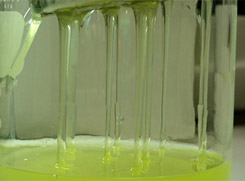
Aloe-vera based DRP extraction |
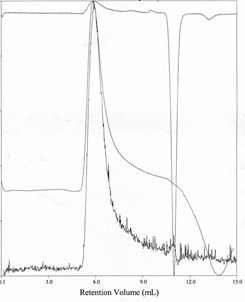
GPC trace of aloe-vera based DRP |
|
| |
|
Degradation of drag-reducing polymers in solution and suspensions
- Characterization of mechanical degradation of DRPs in solution and in suspensions of red blood cells or rigid particles
- Comparison of mechanical degradation rates of various DRPs to find those most stable
- For treatment of chronic conditions such as microcirculatory impairment caused by diabetes or atherosclerosis, a DRP that degrades slowly would be advantageous
|
| |
|
Potential clinical applications of DRPs
- Tests of the hemodynamic efficiency of newly derived and modified DRP preparations
- DRPs have been found to decrease the lethality of hemorrhagic shock.
- The complications of diabetes mellitus caused by hemodynamic alteration may be treated/prevented by injections of DRP solutions
- Chronic injections of DRPs may improve the integration and biocompatibility of bioengineered tissues and constructs
- Due to the enhancement of blood flow to all tissues, chronic injections of DRPs may improve the wound healing process
|
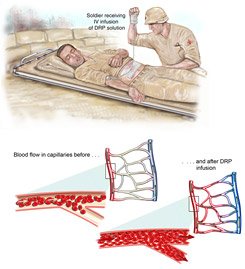 |
| |
|
Hemorheology
- Viscoelasticity studies have been useful in establishing new tests to determine sub-lethal damage to red blood cell
- In vitro rheological studies of the effects of DRPs on red blood cell mechanical properties which may provide new insight into the mechanisms behind the beneficial effects of these polymers on blood circulation
- Rheological differences in blood of men and premenopausal women and their correlation with development of cardiovascular diseases
- Environmental effects on deformability of RBCs
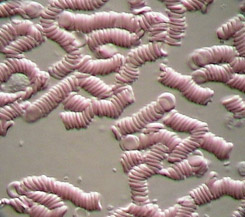
Rat blood demonstrating aggregation |
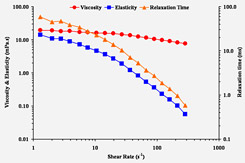
Rat blood viscoelasticity |
|
| |
|
Blood damage
- Assessment of blood damage (measurement of plasma free hemoglobin) caused by mechanical circulatory support devices such as left ventricular assist pumps
- Studies of the effects of mechanical and thermal stresses on sublethal and lethal damage to red blood cells
- Effects of turbulent stresses on mechanical hemolysis
- New pharmacological ways for reducing of mechanical fragility of blood cells and mechanical stress and foreign surface induced blood trauma
|
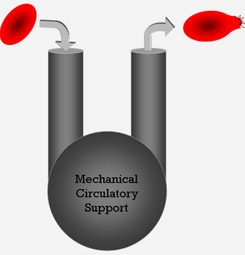
Shear induced hemolysis |
| |
|
Microflow Drag Reducing Polymers (MDRPS)
and Artificial Blood Development
The project's goal is to develop an all-purpose blood substitute that combines the high oxygen carrying and nutrient supplement capability of natural blood with superior fluid properties. The significant novelty of our research is to achieve maximal oxygen delivery to tissues with minimal concentration of oxygen carrier via the superior mechanical and physical properties of the product due to special drag-reducing component of the product. Additional advantages of the product are low toxicity and a low cost due to significantly reduced concentration of an oxygen carrier and development of a novel surfactant. The McGowan Artificial Blood components are being tested in-vitro and in-vivo for the effectiveness and stability. READ MORE
|
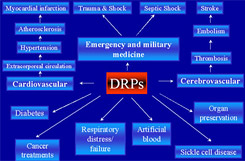 |
| |
|
Rheologic Dissimilarities in Female and Male Blood: Potential Link to Development of Cardiovascular Diseases
Since men possess a higher number of old RBCs with suboptimum mechanical properties, than premenopausal women, who due to monthly bloodloss have a higher number of young cells and a lower number of old RBCs than their male counterparts, our results suggest that an elevated hemorheological risk for males is associated with the age distribution of RBCs. READ MORE
|
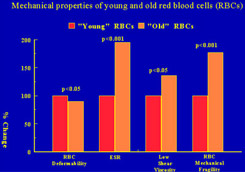 |
| |
|
Theoretical and Experimental Studies of Mechanical Blood Trauma
The development of blood-contacting artificial organs requires that special attention be paid to blood damage that occurs during the device operation. Generally, blood trauma remains a key challenge in the development and improvement of heart-assist devices, blood oxygenators, dialysis machines and peripheral access systems. For example, the major bioengineering challenge in the design of a permanent artificial heart is the reduction of blood damage within the pump, cannulae, and connectors. Because, by definition, these devices must augment the pressure and blood flow delivered to the circulatory system, it is difficult to completely avoid the extremely high shear stress, turbulence, and other hemodynamic and surface related factors which can cause hemolysis and thrombosis. These factors along with possible heat generation may cause mechanical destruction of some erythrocytes (i.e. hemolysis) and changes in their mechanical properties. We perform experimental and theoretical investigations of mechanical blood trauma and the relationship between blood trauma and hemorheological changes, which occur in blood contacting artificial organs. The laboratory also provides services on testing of potential blood trauma in blood-contacting artificial organs and devices. The list of companies served by our laboratory includes Cardiac Assist Technologies, Inc., Vasca, Inc., N x Stage Medical Inc., Renal Solutions Inc., and others. READ MORE |
| |
|
Biomaterial Studies
Development and study of a new procedure for the denucleation (elimination of gas nuclei, which are trapped within interstices of the porous material) and coating of porous materials and surfaces, that can be used for a variety applications. The method is based on the replacement of entrapped air with a biocompatible protein solution following by a heat treatment to denature proteins in the solution to ensure the irreversibility of the denucleation. READ MORE |
| |
|